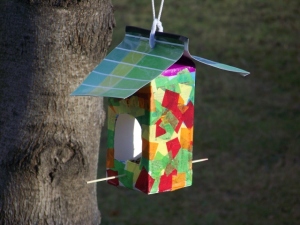When the leaves start to change colour, and the nights are crisp, it is time to put out a birdfeeder for the birds. In Canada, many birds migrate south for the winter, but those who do stay must be able to find food and keep warm. It takes a lot of food to produce the energy to keep warm. You will be helping them to do this.
You may wonder how they manage to stay warm when it is freezing outside. A bird uses it’s feathers to make a warm coat. The soft, fuzzy feathers close to his body trap air and insulate him from the cold just like warm blankets keep you warm on a cold night.
Did you know that most song birds lose their feathers in August and grow new ones? This usually happens very gradually, feather by feather. This is called “molting”. Most birds molt only once a year, but some of the brightly coloured males that have dull winter coats must change again in the spring. The spring molt doesn’t include the wing and tail feathers however.
During molting birds usually stay by themselves except to find food. This is why you don’t see as many birds in late August and early September. Once they have completed their molt they are back again ready to migrate or face the winter.
A bird’s beak and feet give a clue to what it eats. There are webbed feet, scratching feet, taloned feet, perching feet, climbing feet. There are broad, flat beaks, hooked beaks, bug eating beaks, seed crushing beaks and insect catching beaks.
If you don’t already have a bird feeder, create one. You can easily make one from a milk carton or plastic jug with a hole cut in the side and a stick pushed through below. And you can also hang a chunk of suet in an mesh onion bag.
It is really important to keep your feeder clean. Don’t let wet seeds accumulate in the bottom of the feeder as it can harbour bacteria and make the birds sick. Clean it out often!
Take time to watch the birds at your feeder.
PROJECT: Create a bird book – draw the birds that you see and find out more about them.
What colour(s) are they?
What special marks do they have?
What does their beak look like?
What do their feet look like?
What does their tail look like?
What do they like to eat?
What sounds do they make?
What kind of nests do they build?
What do their eggs look like?
Draw and colour them and write about what you have learned.
BOOKS: Bateman’s Backyard Birds, by Robert Bateman, Barron’s – Madison Press – Barron’s Educational Series; 1st edition (2005).


